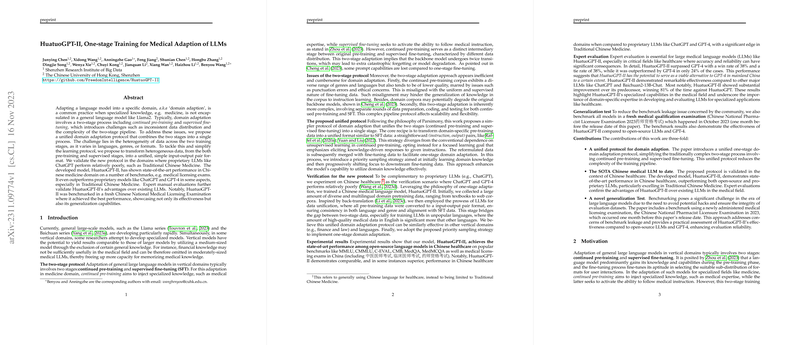An Overview of "HuatuoGPT-II, One-stage Training for Medical Adaption of LLMs"
The paper presents HuatuoGPT-II, a novel approach for adapting LLMs to the medical domain, specifically Traditional Chinese Medicine (TCM). The conventional two-stage adaptation process, involving continued pre-training and supervised fine-tuning, is replaced with a unified one-stage protocol. This simplifies the domain adaptation by transforming heterogeneous pre-training data into a uniform input-output format compatible with fine-tuning data.
Methodology
HuatuoGPT-II is trained using a comprehensive methodology to enhance its performance in the medical domain:
- Data Collection: The authors collect a substantial corpus of both Chinese and English medical texts from diverse sources, including textbooks, online encyclopedias, and academic papers. This is filtered and processed to ensure quality.
- Data Unification: A significant innovation lies in converting varied pre-training data into a uniform format of (instruction, output) pairs. Leveraging LLMs, this process aligns the pre-training data with fine-tuning data, ensuring consistency and mitigating ethical concerns.
- One-stage Training: An integrated dataset is created from the unified data, which is then subjected to a single training phase. A priority sampling strategy is employed to concentrate on domain knowledge initially, gradually transitioning to fine-tuning tasks.
Results and Implications
HuatuoGPT-II's performance is validated on multiple benchmarks, including the Chinese National Medical Licensing Examination. The model demonstrates superior performance to existing models, both open-source and proprietary, within specific evaluation parameters. Notably, it excels in the field of Traditional Chinese Medicine, outperforming even GPT-4 in certain contexts.
The success of HuatuoGPT-II underscores several implications for AI research and application:
- Simplification of Training Processes: The one-stage training model introduces a streamlined approach, potentially applicable to other domains requiring specialized language understanding, such as law or finance.
- Generalization and Benchmarking: The model shows robust generalization capabilities, verified through innovative benchmark tests, including real-time exams, reducing potential biases and enhancing evaluation integrity.
- Future Developments: The framework sets a precedent for reducing complexity in domain adaptation of LLMs. It highlights the importance of domain-specific data transformation and the potential efficiency gains from moving away from traditional two-stage training protocols.
Conclusion
HuatuoGPT-II represents a significant advancement in the medical application of LLMs through its unified training approach. It effectively addresses the challenges associated with traditional adaptation methods, offering insights into the potential for more streamlined and effective model training across various specialized domains. As the field progresses, this work could inspire further innovations in simplifying LLM adaptation processes, enhancing their practical deployment in specialized areas.
